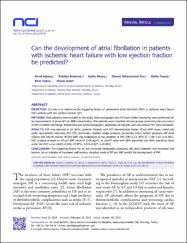| dc.contributor.author | Alpsoy, Şeref | |
| dc.contributor.author | Erselcan, Kubilay | |
| dc.contributor.author | Akyüz, Aydın | |
| dc.contributor.author | Özkaramanlı Gür, Demet | |
| dc.contributor.author | Topuz, Sahin | |
| dc.contributor.author | Topçu, Birol | |
| dc.contributor.author | Güler, Niyazi | |
| dc.date.accessioned | 2022-05-11T14:40:10Z | |
| dc.date.available | 2022-05-11T14:40:10Z | |
| dc.date.issued | 2020 | |
| dc.identifier.issn | 2148-4902 | |
| dc.identifier.uri | https://doi.org/10.14744/nci.2019.07078 | |
| dc.identifier.uri | https://hdl.handle.net/20.500.11776/8886 | |
| dc.description.abstract | OBJECTIVE: Our aim is to determine the triggering factors of paroxysmal atrial fibrillation (PAF) in ischemic heart failure (HF) patients with low ejection fraction (EF). METHODS: Sixty patients were included in this study. Echocardiography and 24-hours Holter monitoring were performed after measurement of serum NT-pro BNP concentration. The patients were classified into two groups concerning the occurrence of PAF on Holter recordings. Biochemical and echocardiographic parameters of patients with and without PAF were compared. RESULTS: PAF was detected in 28 (46%) patients. Patients with PAF demonstrated higher NT-pro BNP levels, mitral and aortic regurgitation velocities, E/A, E/E', pulmonary capillary wedge pressure, pulmonary artery systolic pressure, left atrial volume and volume indices. NT-pro BNP was established as the predictor of PAF (OR=1.23, 95% CI: 1.08-1.42; p=0.001).ROC analysis showed an NT-pro BNP value of 2188 pg/mL as cut-off value with 68% sensitivity and 84% specificity [Area under the ROC curve (AUC)=0.826, CI 95%: 0.724-0.927; p<0.001]. CONCLUSION: The triggering factors for AF are increased intracardiac pressures, left atrial dilatation and increased wall tension. As an indicator of increased wall tension, elevated levels of NT-pro BNP predict the development of PAF. | en_US |
| dc.language.iso | eng | en_US |
| dc.publisher | Kare Publ | en_US |
| dc.identifier.doi | 10.14744/nci.2019.07078 | |
| dc.rights | info:eu-repo/semantics/openAccess | en_US |
| dc.subject | Atrial fibrillation | en_US |
| dc.subject | heart failure | en_US |
| dc.subject | ischemic | en_US |
| dc.subject | low ejection fraction | en_US |
| dc.subject | 2016 Esc Guidelines | en_US |
| dc.subject | Natriuretic Peptide | en_US |
| dc.subject | Risk-Factors | en_US |
| dc.subject | Association | en_US |
| dc.subject | Collaboration | en_US |
| dc.subject | Management | en_US |
| dc.subject | Society | en_US |
| dc.title | Can the development of atrial fibrillation in patients with ischemic heart failure with low ejection fraction be predicted? | en_US |
| dc.type | article | en_US |
| dc.relation.ispartof | Northern Clinics of Istanbul | en_US |
| dc.department | Fakülteler, Tıp Fakültesi, Dahili Tıp Bilimleri Bölümü, Kardiyoloji Ana Bilim Dalı | en_US |
| dc.identifier.volume | 7 | en_US |
| dc.identifier.issue | 1 | en_US |
| dc.identifier.startpage | 18 | en_US |
| dc.identifier.endpage | 24 | en_US |
| dc.institutionauthor | Alpsoy, Şeref | |
| dc.institutionauthor | Akyüz, Aydın | |
| dc.institutionauthor | Özkaramanlı Gür, Demet | |
| dc.institutionauthor | Topuz, Sahin | |
| dc.institutionauthor | Güler, Niyazi | |
| dc.relation.publicationcategory | Makale - Uluslararası Hakemli Dergi - Kurum Öğretim Elemanı | en_US |
| dc.identifier.wos | WOS:000514812200004 | en_US |
| dc.identifier.pmid | 32232199 | en_US |



















